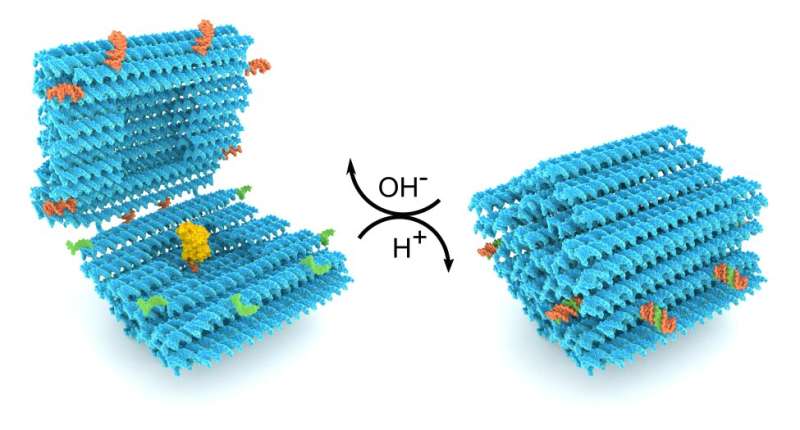DNA folds into a smart nanocapsule for drug delivery

Researchers from University of Jyväskylä and Aalto University in Finland have developed a customized DNA nanostructure that can perform a predefined task in human body-like conditions. To do so, the team built a capsule-like carrier that opens and closes according to the pH level of the surrounding solution. The nanocapsule can be loaded—or packed—with a variety of cargo, closed for delivery and opened again through a subtle pH increase.
The function of the DNA nanocapsule is based on pH-responsive DNA residues.
To make this happen, the team designed a capsule-like DNA origami structure functionalized with pH-responsive DNA strands. Such dynamic DNA nanodesigns are often controlled by the simple hydrogen-bonding of two complementary DNA sequences. Here, one half of the capsule was equipped with specific double-stranded DNA domains that could further form a DNA triple helix—in other words a helical structure comprised of three, not just two DNA molecules—by attaching to a suitable single-stranded DNA in the other half.
"The triplex formation can happen only when the surrounding pH of the solution is right. We call these pH-responsive strands 'pH latches,' because when the strands interact, they function similarly to their macroscopic counterparts and lock the capsule in a closed state. We included multiple motifs into our capsule design to facilitate the capsule opening/closing based on cooperative behaviour of the latches. The opening of the capsule is actually very rapid and requires only a slight pH increase in the solution," explains first author of the study, doctoral student Heini Ijäs from Nanoscience Center at University of Jyvaskyla..
Nanoparticles and enzymes could be loaded and encapsulated within the capsules
To harness the nanocapsules for transporting molecular payloads or therapeutic substances, the team designed the capsule with a cavity that could host different materials. They demonstrated that both gold nanoparticles and enzymes could be loaded (high pH) and encapsulated within the capsules (low pH) and again displayed (high pH). By monitoring the enzyme activity, the researchers found that the cargo remained fully functional over the course of the process.
"The most intriguing thing about the DNA origami capsules is that the threshold pH at which the opening and closing take place is fully adjustable by selecting the base sequences of the pH latches. We designed the threshold pH to be 7.2-7.3, close to the blood pH. In the future, this type of drug carrier could be optimized to selectively open inside specific cancer cells, which can maintain a higher pH than normal healthy ones," says Veikko Linko, Adjunct Professor at Aalto University.
Further, the capsules remained functional at physiological magnesium and sodium concentrations, and in 10 percent blood plasma, and may continue to do at even higher plasma concentrations. Together, these findings help pave the way for developing smart and fully programmable drug-delivery vehicles for nanomedicine.
More information: Heini Ijäs et al. Reconfigurable DNA Origami Nanocapsule for pH-Controlled Encapsulation and Display of Cargo, ACS Nano (2019). DOI: 10.1021/acsnano.9b01857
Journal information: ACS Nano
Provided by University of Jyväskylä





















